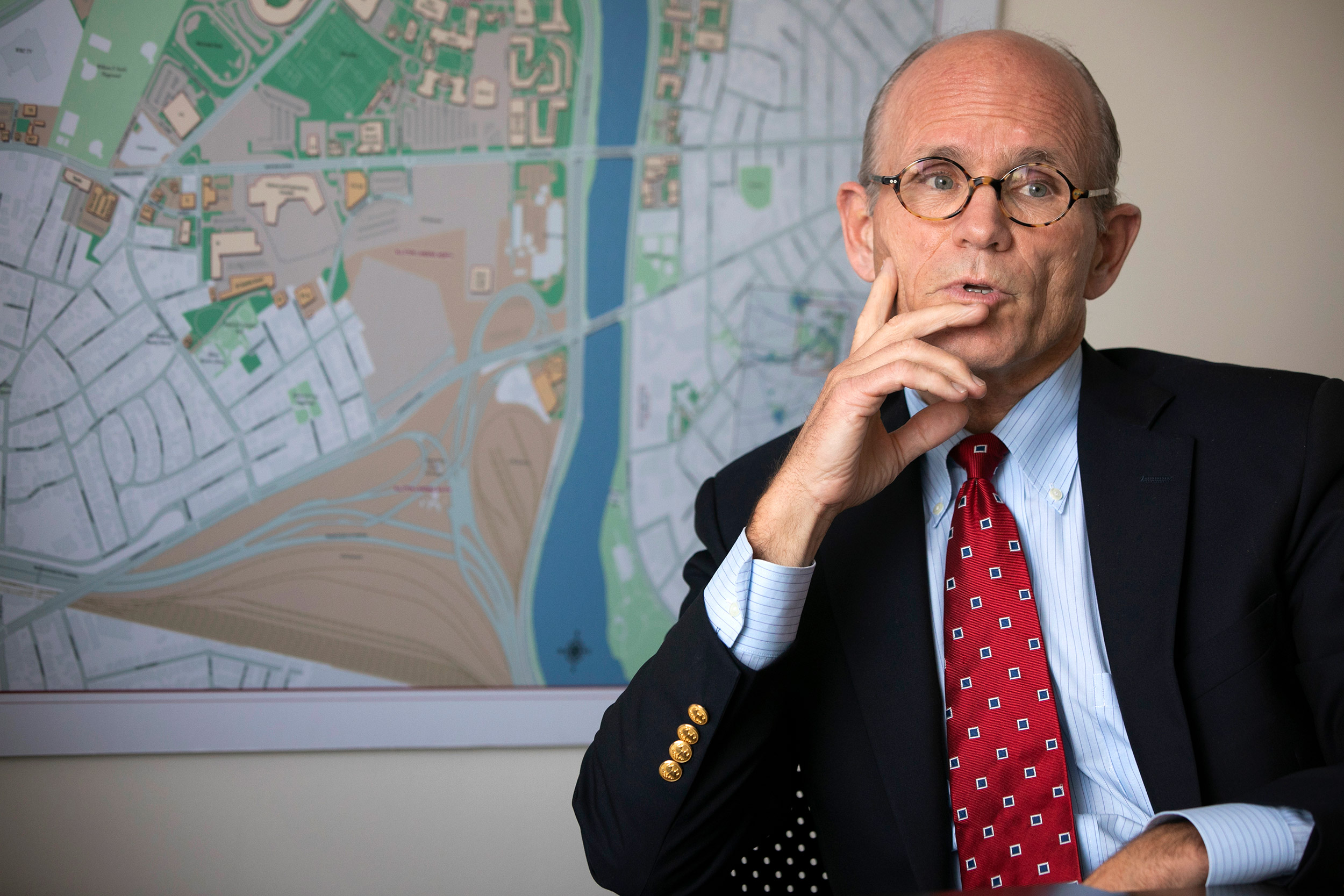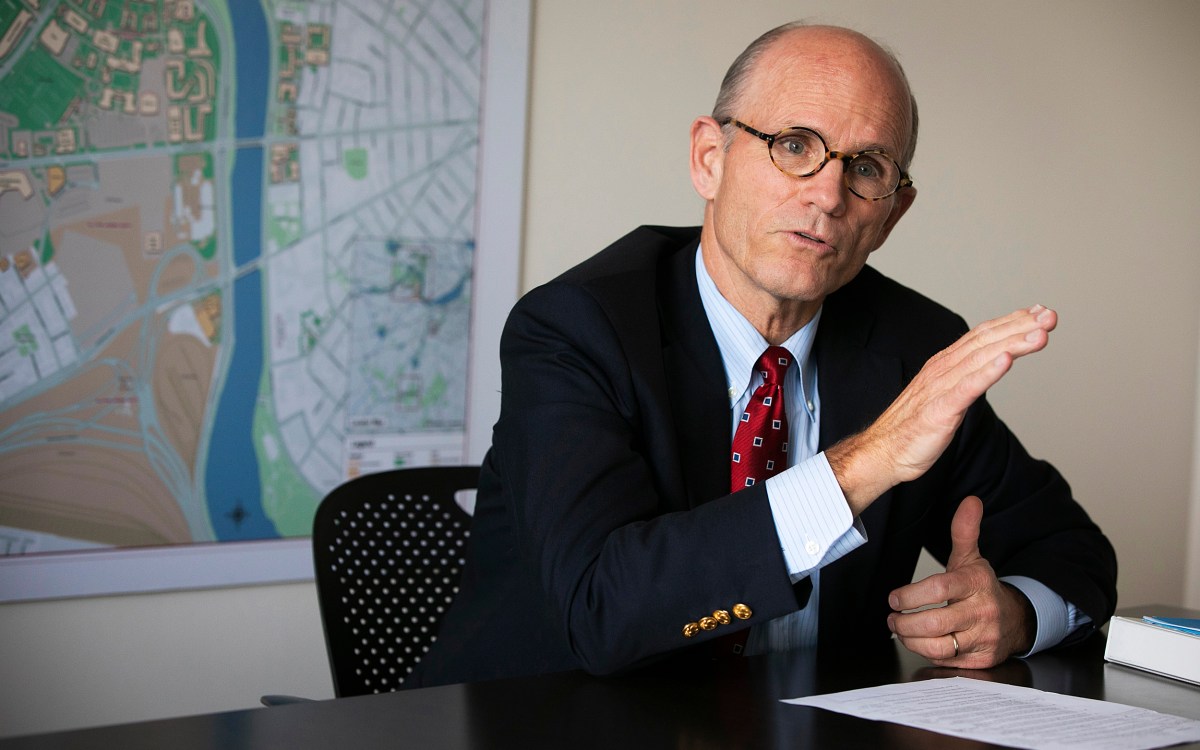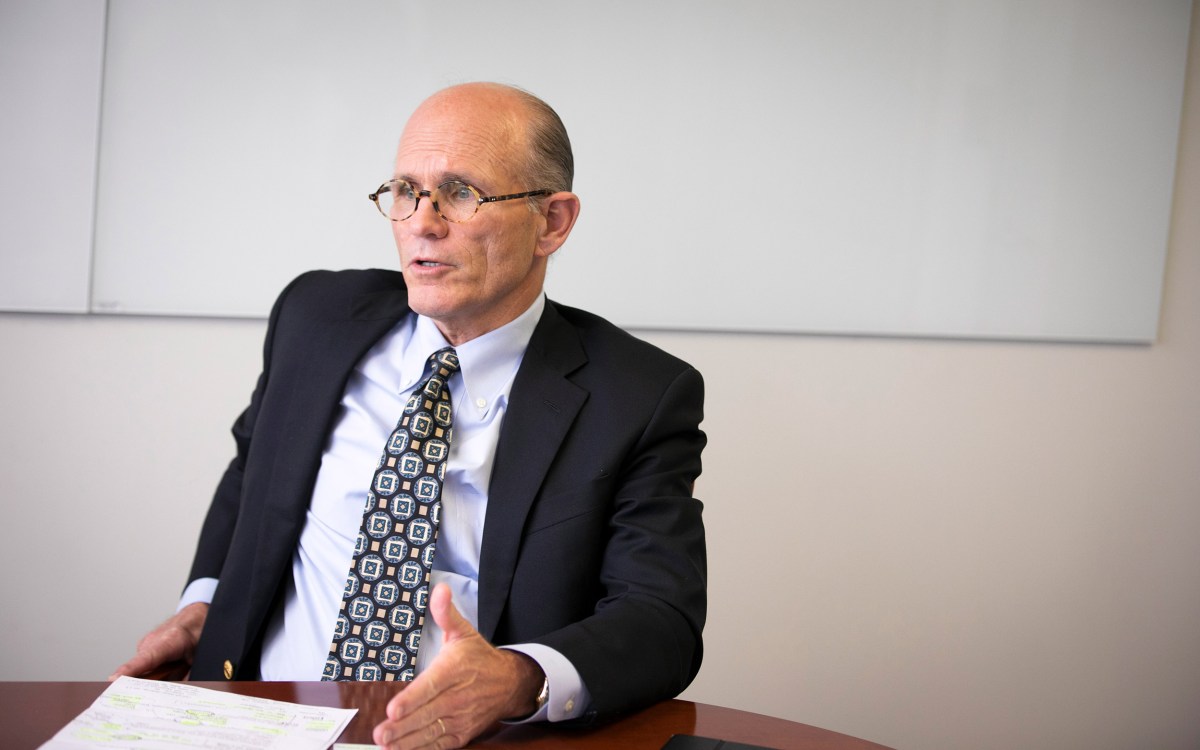
The John Harvard Statue overlooks Harvard Yard.
Stephanie Mitchell/Harvard Staff Photographer
An uncertain financial road ahead
Finance chief calls for renewed community commitment to University’s core principles
The COVID-19 pandemic continues to create financial challenges for colleges and universities across the country, including Harvard, which has forecast significant revenue shortfalls for fiscal years 2020 and 2021. Since the onset of the outbreak, the Gazette has periodically checked in with Thomas J. Hollister, Harvard’s vice president for finance and chief financial officer, for updates on how the pandemic has affected the University’s finances. We recently spoke with him about the current outlook and how leaders of the University and its Schools and units are doing in their efforts to protect the health of the community as well as to preserve Harvard’s enduring mission to teaching and research.
Q&A
Thomas Hollister
GAZETTE: The University reopened campus for the fall semester to a limited number of Harvard community members. Could you provide context into how financial resources were aligned to support these efforts?
HOLLISTER: Before commenting on resources, let me just say something on planning and logistics. So far, Harvard has successfully reopened research labs, broadened and intensified its excellent remote learning offerings, established hybrid classrooms, and selectively returned a limited number of students, faculty, and staff to campus with rigorous testing and tracing practices. It has been an extraordinary effort in imagination, academic and administrative planning, and old-fashioned hard work across Harvard’s Schools and in central administration. We are grateful to everyone who has been involved in these considerable efforts.
So, to your question. Harvard has focused on three main guiding principles since the University decided to move to virtual learning last March: ensuring the safety of our community members, delivering on our mission in teaching and research, and supporting our people. To be able to continue to follow these principles at a level consistent with what we aspire to at Harvard, and during a pandemic, we have needed to make significant new investments, and we have increased our spending in targeted areas. This includes costs associated with COVID-19 testing and tracing, the reconfigurations of laboratories, as well as classrooms and dormitories, the procurement of personal protective equipment, and investments in technology and training for remote and hybrid learning, for faculty and students alike. Testing and tracing costs alone will be tens of millions of dollars. To help the deans of Harvard’s Schools cover a portion of this additional spending, members of the Corporation voted a special assessment earlier during the spring on the coming year’s distribution. But the challenge of funding these measures is amplified, of course, given Harvard’s declining revenues directly related to the realities of the pandemic.

GAZETTE: We have been hearing from University leadership, and you referenced it here, that Harvard’s core mission will continue to be central to the administration’s decision-making. How does Harvard continue to invest in its mission of teaching and research, even as COVID-19 continues to pose myriad challenges?
HOLLISTER: It’s a great question. How do you invest more when revenues are declining? Doing so requires a careful examination of priorities, tough choices, and a reallocation of resources. We have made cuts in discretionary spending, frozen new hires and salaries, and offered a voluntary early retirement program. All of these moves have helped.
As the University leaders make decisions, teaching, research, and financial aid will remain at the top of the list for what is most important to continue to support. Still, every part of Harvard has felt, or will feel, the impact of either declining or reallocated resources.
GAZETTE: It was previously announced to the Harvard community that the University was projecting shortfalls of anticipated revenue in fiscal year 2020, which ended June 30, and in the new fiscal year 2021. What uncertainties does the University continue to face that complicate the forecast of Harvard’s financial outlook moving forward, as we remain entrenched in the challenges of the pandemic?
HOLLISTER: The previous consolidated revenue loss estimates that you reference were based on forecasts across all of the University’s Schools and units, both just before, and not long after, the onslaught of the pandemic. Since then, we’ve learned more about the impact of the pandemic on the University’s finances — and our understanding continues to evolve over time.
With respect to FY20, we will not have final numbers until next month. I do know enough to say, however, that revenues for this past year were down substantially from FY19. That is only the second decline of Harvard’s revenues since World War II. The other time was during the Great Recession of ’08 and ’09. And the staggering part about the losses of revenue — including due to room and board rebates, cancellation of continuing- and executive-education programs, sharp drops in rental income, health-related services, parking fees, and so on — was that it all occurred in a little over three months in the spring.
With respect to FY21, our most recent forecasts indicate that revenues will likely be down a second year in a row. We haven’t seen that since the 1930s. The key point, though, referenced in your question, is the uncertainty. We face extraordinary, in some ways unprecedented, challenges related to the pandemic and ones that extend beyond it, including the economy, politics, societal inequities, and pressures in higher education. Each of these forces could have an effect, in varying degrees, on the University’s financial outlook for the year.
“Some things will receive funding, and some will not. We cannot treat all activities the same, with a ‘spreading peanut butter’ approach.”
GAZETTE: Could you provide further context for what difficult decisions related to the University’s finances may need to be considered as the financial outlook does become clearer?
HOLLISTER: Given the levels of uncertainty, we need to be as flexible and adroit as possible. The reality is, we just don’t know what is going to unfold, even as we engage in planning for things like the spring semester. Working with the Corporation Committee on Finance, Harvard has established three overriding financial principles to maintain during the pandemic: to stay “liquid” (which is to say, have cash available), to endeavor to reduce spending in line with declining revenues, and to be on the lookout for investment opportunities that will strengthen the mission for the future.
You will notice that there is tension embedded in those goals. How do you reduce spending and invest at the same time? That is difficult. As I’ve already mentioned, doing so requires hard thinking, prioritization, and difficult decisions. Some things will receive funding, and some will not. We cannot treat all activities the same, with a “spreading peanut butter” approach.
One key point of context is the perception, by some, that Harvard has unlimited resources. As I have said previously in this space, Harvard is well-resourced and has [leveraged] and will continue to leverage those resources during this unprecedented time. We cannot, however, continue to deficit spend on an operating basis, or spend irresponsibly or unsustainably from the endowment. Like all organizations, we have to find a way to live within our means, and we cannot do everything everyone wants.
GAZETTE: Are there any other messages that the Harvard community should be aware of during these difficult times?
HOLLISTER: We will make it through this period, but the worst economic pressures brought on by the pandemic are likely still ahead of us. Despite this reality, I remain confident that we will be able to continue to prioritize our essential mission activities. Harvard’s decentralization provides an enormous advantage in that resources are often managed locally by those people who are the most involved in both the academic and other activities of the Schools.
This means that now is a time for each and every one of us to take an interest in, and to assume a vigilant responsibility toward, ensuring that our declining resources continue to best support our commitment to teaching and research. Already, I have seen countless contributions from administrators, faculty, and staff across the University to do just this, despite the ongoing adversity. I think that should provide us all with hope and confidence.
[gz_email_signup /]






